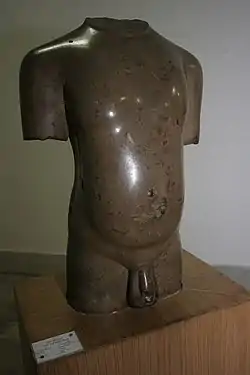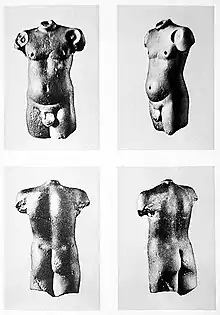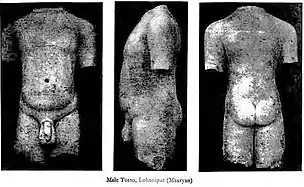| Lohanipur torso | |
|---|---|
 Lohanipur torso, Patna Museum. | |
| Material | Polished sandstone |
| Period/culture | 3rd century BCE ~ 2nd century CE |
| Discovered | 25°36′23″N 85°09′16″E / 25.606366°N 85.154401°E |
| Place | Lohanipur, Patna, Bihar, India. |
| Present location | Patna Museum, India |
 Lohanipur | |
The Lohanipur torso is a damaged statue of polished sandstone, dated to the 3rd century BCE ~ 2nd century CE, found in Lohanipur village, a central Division of Patna, ancient Pataliputra, Bihar, India.[1] There are some claims however for a later date (not earlier than the Kushana period), as well as of Graeco-Roman influence in the sculpting.[2]The Lohanipur torso is thought to represent a Jaina Tirthankara.[3]
K. P. Jayaswal and M. A. Dhaky have regarded this to be the earliest Jain sculpture found.[4] The Didarganj Yakshi is another polished statue from Patna whose date is disputed, with the possible range between the Mauryan and Kushan periods.
Finding
The 2-foot torso is one of the two found in 1937 in an area of Patna. The smaller torso is one foot tall.[4] Historian K.P. Jayaswal reported that the excavation of the site revealed a Mauryan coin and a number of Mauryan bricks from a square shaped temple, suggesting the torso is from the Mauryan period.
Description
The Lohanipur torso is thought to represent a Jaina Tirthankara.[3] The statue is an outstanding example of Mauryan polish, an advanced polishing technique essentially characteristic of the Mauryan Empire, which almost fell out of use after that period, although, if it is of a later date, it might suggest that polishing techniques survived the Mauryan era.[5]
Comparison with the Harappa torso
The Lohanipur torso bears a striking resemblance with the Harappan jasper torso excavated in the 1928/29 season by Madho Sarup Vats, to the south of the "Great Granary" at Harappa. This ought to belong to the Mature Harappan period based on the dating of the site strata, but its date is questioned or disputed by scholars such as the British archaeologists Mortimer Wheeler or John Marshall, who suggested a historical period, probably Gupta (circa 500 CE).[6][7] In 2002, the anthropologist Gregory Possehl commented that "it seems reasonable" that the piece belongs to the Mature Harappan period, exhibiting "the heights to which Indus artists could reach".[8] In that case, the Harappa torso would date to 2300–1750 BCE.[9]
See also
References
Citation
- ↑ Olivelle 2006, p. 399.
- ↑ Pereira 2001, p. 11.
- 1 2 Shah 1995, p. 15.
- 1 2 Cort 2010, pp. 32–33.
- ↑ Pereira 2001, p. 10.
- ↑ Possehl 2002, p. 112.
- ↑ McIntosh 2008, p. 281.
- ↑ Possehl 2002, pp. 111–112.
- ↑ Honour & Fleming 2005, p. 65.
Sources
- Cort, John E. (2010) [1953], Framing the Jina: Narratives of Icons and Idols in Jain History, Oxford University Press, ISBN 978-0-19-538502-1
- Honour, Hugh; Fleming, John (2005) [1982], A World History of Art (7th ed.), Laurence King Publishing, ISBN 9781856694513
- McIntosh, Jane (2008), The Ancient Indus Valley: New Perspectives, Understanding ancient civilizations, ABC-CLIO, ISBN 9781576079072
- Olivelle, Patrick (2006), Between the Empires: Society in India 300 BCE to 400 CE, Oxford University Press, ISBN 9780199775071
- Pereira, Jose (2001), Monolithic Jinas, Motilal Banarsidass, ISBN 9788120823976
- Possehl, Gregory L. (2002), The Indus Civilization: A Contemporary Perspective, Rowman Altamira, ISBN 9780759101722
- Shah, Umakant Premanand (1995), Studies in Jaina Art and Iconography and Allied Subjects in Honour of Dr. U.P. Shah, Abhinav Publications, ISBN 9788170173168
External links
 Media related to Lohanipur torso at Wikimedia Commons
Media related to Lohanipur torso at Wikimedia Commons

